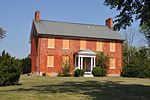Mill Creek Historic District (Bunker Hill, West Virginia)

Mill Creek Historic District is a national historic district located at Bunker Hill, Berkeley County, West Virginia. It encompasses nine contributing buildings, eight contributing sites, and three contributing objects that relate to an early industrial-commercial center in the county. They include: the Mill Creek Bridge (c. 1914), Henry Sherrard Mill (c. 1790), Robert Daniels House (c. 1790), John Gray House, Henshaw Log House (c. 1820), "Springhill" (late 18th century), Henshaw Miller's House (c. 1780), "Springfield" (c. 1775), Holliday Mill Sites, Bunker Hill Cumberland Valley Railroad Bridge, Stephenson's Tavern, Morgan Park including two State markers and monument (1924) to Morgan Morgan, Elisha Boyd Mill Sites, Joel Ward Mill ruins, Bunker Hill Mill Complex, and Joel Ward House (c. 1750, burned 1988).It was listed on the National Register of Historic Places in 1980.
Excerpt from the Wikipedia article Mill Creek Historic District (Bunker Hill, West Virginia) (License: CC BY-SA 3.0, Authors, Images).Mill Creek Historic District (Bunker Hill, West Virginia)
Henshaw Road,
Geographical coordinates (GPS) Address Nearby Places Show on map
Geographical coordinates (GPS)
| Latitude | Longitude |
|---|---|
| N 39.345833333333 ° | E -78.061388888889 ° |
Address
Henshaw Road 1027
25413
West Virginia, United States
Open on Google Maps










